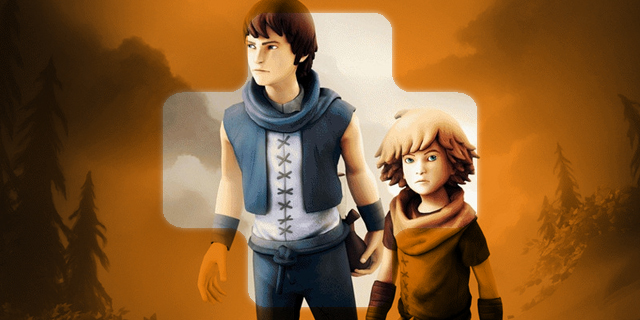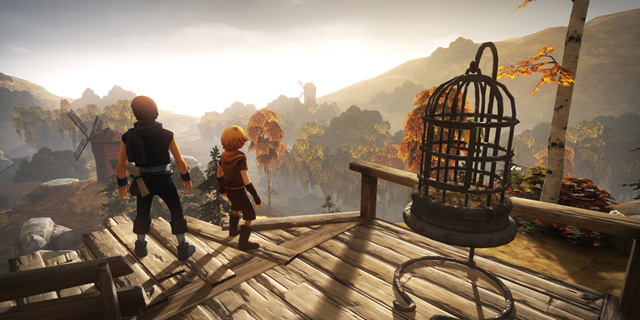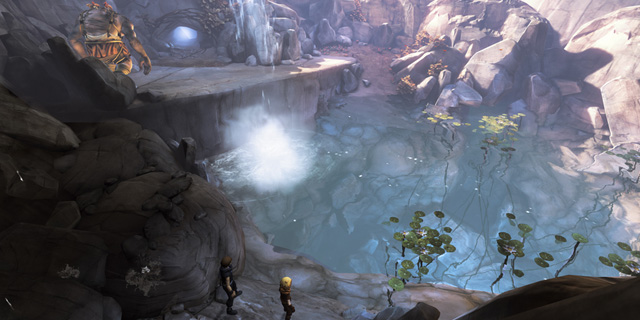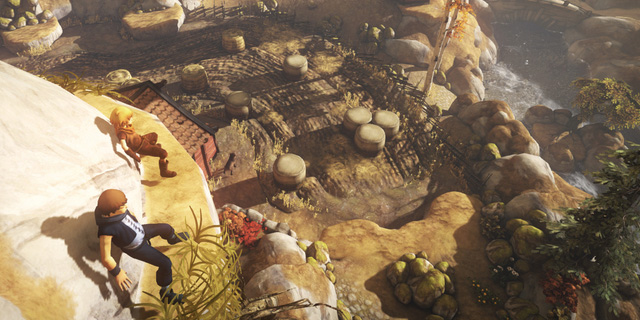
This column contains full story spoilers for Brothers, so if you haven’t had a chance to play it yet, don’t read on. Also, go play it. You’ll thank me later.
Last time, I discussed fundamental game mechanics that help certain games stand out when they might not otherwise. Gunpoint was the prime example, with its excellent jumping mechanic laying the groundwork for the rest of the game’s brilliant design. Sometimes, however, this singular mechanic can not only help a game stand out, but make its story more impactful as a result.
The one title that comes to mind immediately is Starbreeze’s recent downloadable release, Brothers: A Tale of Two Sons. It may just be the perfect example of how to handle a basic mechanic, and how that single part can turn a game from something merely great into one of the most memorable games in quite some time.
The concept is simple: two brothers, who just recently lost their mother and have to learn to deal with loss for the first time, need to aid their sick father. In order to do so, they must travel beyond their village to fantastical lands that stretch beyond the limits of their own imaginations. That’s the game’s plot in a nutshell, as you know, so it never occurred to me just how much its basic plot and simplistic characters could actually affect me. Most importantly of all, it manages to make the impact of certain events all the more memorable because of its control scheme.

The most distinctive thing about Brothers from a gameplay perspective is how it controls. This is a game all about the connection between siblings, so allowing you to control both brothers at once is something that is absolutely necessary to make the bond between seem that much more real. Each brother is controlled by one of the analog sticks, with each getting their own trigger as an action button, giving you the chance to have simultaneous control. You probably already know how difficult it is to get used to it despite how limited the controls actually are, but once you get a handle on it, it becomes second nature.
Both brothers play a role in the ensuing adventure, and as a result it never feels like an escort mission. Sure, one of the siblings is younger and perhaps less experienced than the other, but with his brother by his side, he feels stronger and more able to do things he might not otherwise. For example, when you first get to a body of water, you quickly learn the younger brother can’t swim. Thankfully, the older brother is just strong enough to carry him, allowing the two to work together to cross the water with no problems.
The game is full of little moments where their cooperation feels absolutely necessary. The rope segment, in which both brothers are tied together and must use each other’s strength to swing from area to area, is a testament to how amazing the control scheme works, both mechanically and in terms how much they must trust each other. Because you are in control of both of them, your ability to perform these tasks which require both brothers to work together almost determines their bond. If you slip up, that’s a betrayal of trust. Any missteps or wrong moves on my part made me begin to feel as if I was betraying the characters, even if nothing like that was ever indicated. I never once wanted to break the bond the two had.

As I continued to play, I thought more about these connections and how they continued to help their relationship in the long run. The story is very sparse, with only some brief scenes laying out key moments for the majority of the adventure. The landscapes and environments tell the story, as well as your actions. As you struggle to adapt to the controls, you can feel the struggle the two brothers are facing as they overcome obstacles they never dreamed they would be facing.
One of my particular favorite moments was actually completely unrelated to the story. Along the way, you’ll encounter an older man with a rope tied around both his neck and the branch of a tree. His fate almost seemed sealed at that point, but luckily you can use both brothers to both grab his feet and cut the rope, giving him a second chance at life. At first I thought this was entirely scripted and I was just forced to watch as this man, whom I never met, took his own life for a reason these two young kids would clearly never understand. Despite that, I was able to save him, thanks to the brothers’ ability to work together even in the most dire of scenarios.
Eventually, you begin to take this connection for granted, always ready to have thumbs on both analog sticks to move the pair in unison. Unfortunately, the game’s strongest moment takes that comfort away from you, leaving you with that same familiar disconnect you felt with the controls when you first started.

After being tricked by a young woman, who in actuality is a spider-creature hell bent on making the two brothers her next meal (who would have guessed?), the older brother is seriously injured. His survival seems inevitable, and you rush to grab the cure for your father that will surely also help your brother back on his feet. But as soon as you arrive at the place you left him, you find his lifeless body. It’s not an easy moment to handle, and it’s one that took me completely by surprise. Once again, I took something for granted, never once expecting the game to rip it away from me.
This is why, despite the death of the older brother, your realization that you are all alone is really the game’s greatest strength. It gave you three hours to master this seemingly-tricky control scheme only to, essentially, cut off your left hand just minutes before the final moments. During those last sections, you feel a sense of loneliness that comes from the loss of a character you thought would always be there, all thanks to a mechanic that seems silly initially but slowly grows over time. It’s a stroke of genius and, to me, felt like the game’s control scheme was built around making that one moment as powerful as possible. It worked.
Some people say that many story-focused games, especially those with excellent narratives and very light gameplay, would make better novels than interactive experiences. Perhaps, in some rare instances, it’s the right way of thinking about it, but Brothers shows just how you can make a game’s story have impact equally through both its cutscenes and gameplay mechanics. Like Gunpoint, it demonstrates an ability to start with an excellent base mechanic and design a game around that, rather than implementing several different elements as a result of the rest of the game’s design. While Brothers takes this idea in a much different direction due to its story, it does so much to expand just how well you can implement game mechanics and narrative without one compromising the other.



















